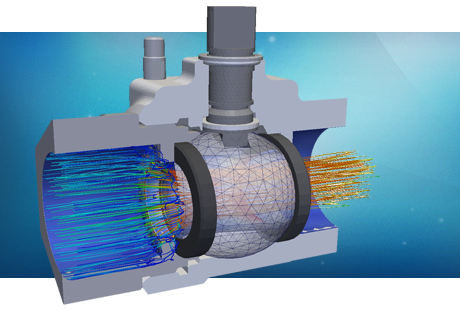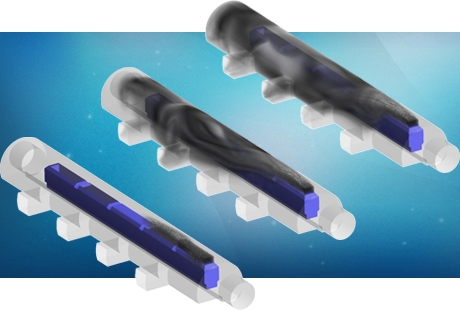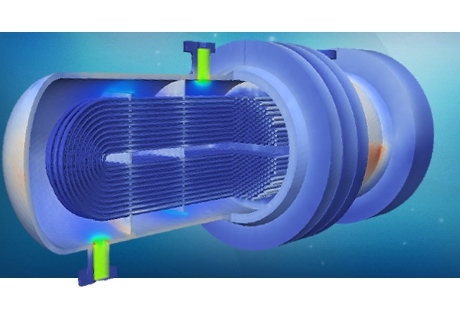CAT III assessments for tunnel and station ventilation systems
Background
Fire safety is a complex and wide ranging discipline, requiring a system based approach to the evaluation of risk and emergency scenarios. Typically, two principal effects of fires are the focus of detailed analysis: structural fire damage and smoke management.
The concerns with fire dynamics in tunnels have been the focus in numerous investigations at an academic and regulator level. In all of these instances, Computational Fluid Dynamics (CFD) has been recognised as a valid tool to assist in the technical assessment of the system design.
PRE Technologies have developed a methodology to use a strategically selected set of CFD simulations for the verification of key performance criteria in the fire safety assessment of railway and highway subsurface infrastructures. The objective is to independently verify the safe design of the ventilation systems in response to a set of fire scenarios, ensuring key criteria (i.e. a satisfactory egress time), provided by the client or relevant safety standards, are achieved.
Methodology
A comprehensive set of 3D, transient, CFD simulations are proposed for each of the load cases identified in the load case matrix (based on system functionality and safety requirements). Commercial and proprietary CFD codes are used to solve the 3D Navier-Stokes equations in order to obtain the transient flow fields, using a finite volume method. A suitable turbulence model is selected based on the expected flow nature to model flow turbulence structures. It is proposed that the focus of the initial assessments is not to capture the accurate spreads of fire but to conservatively determine the spread of smoke and heat in the environments under examination. Should the fire start and initial development not be characterised and defined by the client, a local model of the fire start arrangement and the simulation of the initial fire spreading instants is proposed. This will then be the input for the smoke spreading calculations.

Individual species transport is modelled using full multicomponent diffusion (Stefan-Maxwell diffusion) and thermal diffusion, where energy and mass transfer are modelled. Source and sink terms are added to these equations to account for the smoke and heat generation. As with the smoke generation procedure, heat generation is modelled through the addition of a source term into the energy equation. This source term is generally constant, assuming that the peak heat release rate (HRR) is sustained for the duration of the fire simulation (conservative).
Radiation can be an important phenomena in the heat transport process, especially for the surfaces and smoke volume in the vicinity of the reaction area (flame). This process is accurately modelled by PRE Technologies, however it is heavy computationally speaking, leading to longer running times.
Fire Dynamics
The understanding of fire dynamics within tunnels is critical to the management of fire emergencies in underground rail and highway systems. The heat feedback to the burning objects is much stronger in tunnel fires, leading the maximum Heat Release Rate (HRR) to increase up to four-fold compared to an open fire.
Fires typically grow to a peak HRR which may be sustained for a period of time (following flashover) before decaying. In tunnels, the fire dynamics are dominated by the availability of combustible fuel and ventilation. The type of fuel determines the HRR growth and peak as well as the production rate and composition of burnt products and particulates (soot).
For the purpose of a Category 3 study, in the absence of more detailed HRR history, a conservative approach is often taken: it is assumed that the peak HRR will be sustained for the duration of the fire (i.e. excess source of fuel). Furthermore, fire growth is not modelled; an estimation of the maximum fire growth over the period of interest is made in advance and the maximum fire size is then modelled as constant throughout the simulation, again providing a conservative estimate of heat and smoke release.
When the tunnel ventilation is insufficient, the back layering of smoke occurs. The upper layer of heated air and smoke reverses and moves against the direction of the ventilation flow, which can present hazards by propagating toxic fumes and gas away from the fire and complicating firefighting procedures.
Acceptance criteria
The simulation methodology provides an exhaustive map of temperature and smoke concentration. From the time dependent map of these parameters, compliance with predefined safety criteria for the Available Safe Egress Time (ASET) will be determined. The philosophy for their determination is generally as follows:
- Temperature Exposure – This criterion is satisfied when the temperature is below a stated value, deemed to be harmful (e.g. ≤60°C).
- Intoxicant Exposure – This criterion is satisfied when the concentration of intoxicant (principally CO) is deemed to be below the required Short-Term Exposure Limits (STEL) (e.g. ≤200 ppm in 15 mins).
- Visibility – This criterion is satisfied when a defined lower limit of visibility is achieved. The limit is often based on the station/tunnel layout and on the emergency signs, with the intent to ensure passengers have sufficient visibility to see their escape route. Visibility is defined by the mass concentration of particulate and the specific extinction coefficient. These parameters are features of the smoke composition.
A safe ventilation system will ensure that, for the duration of the simulation, all three of these criteria are satisfied within the passenger-occupied volume. The design will also be deemed satisfactory when the ASET is found to be greater than the RSET by a reasonable safety factor. For example, ASET ≥ 1.5 RSET.
Example
A simplified test case is presented to demonstrate PRE Technologies methodology and the power of CFD in assessing ventilation systems in fire events in enclosed spaces. The analysis highlights the carbon dioxide and monoxide mass concentration, smoke dispersion, visibility and velocity of the airflow through an subsurface railway station and through a section of the adjacent tunnel network. The following figure shows the geometry used for this test case. Fire occurs on the first coach of the train, which has safely reached the station.

Carbon monoxide and carbon dioxide concentration
The concentration of carbon monoxide and carbon dioxide in the vicinity of the fire and in the escape routes is critical to ensure the tunnel ventilation system is properly dimensioned. Following the methodology for smoke generation and diffusion, as well as the tracking of product species (CO and CO2), the next figure presents the CFD results for the carbon dioxide mass concentration in two planes (Horizontal and Vertical) at three different times. In the load case presented it is assumed that the train has reached the station and the coaches are situated alongside the platform when the fire develops.


Smoke dispersion
The generation of smoke is defined based on the expected fuel composition. For the purpose of this study, the smoke generation was modelled as a 1-step reaction mechanism, occurring in a predefined zone, producing burnt gaseous products (composition dependant on the fire start arrangement) and particulate matter.
The combustion reaction is generally modelled implicitly, i.e. the complex interaction between reaction kinetics and turbulent flow is simplified to obtain the general picture of the fire event. As explained before, fire growth is not modelled, instead an estimation of the maximum fire growth is made and the maximum fire size is modelled as constant throughout the simulation. Within this region, source and sink terms replace the explicit simulation of the chemical reaction and account for the oxygen consumption and the production of smoke (gases and soot). This is a well established procedure with comparable results to combustion models. The consumption and production rates to be used in the sink and source terms are often obtained from literature, taking into consideration the type of solid fuel.
The figure on the side presents the CFD results for the carbon dioxide mass concentration in two planes (Horizontal and Vertical) at three different times (A, B and C) for when the fire occurs on the train while situated at the platform.
Visibility
Visibility is probably the most relevant parameters when assessing the dimensioning and design of escape routes. It is also one of the most difficult parameters to obtain as it highly depends on the nature of the burning elements. Literature and international safety guidelines provide a number of criteria for this parameter. It generally requires the designer to ensure there is enough visibility at a height of 2 meters from the ground to be able to follow the evacuation indications.
This criterion is satisfied when a defined lower limit of visibility is achieved. The limit is often based on the station/tunnel layout and on the emergency signs, with the intent to ensure passengers have sufficient visibility to see their escape route. Visibility (S, in m) is defined by the mass concentration of particulate (mp) and the specific extinction coefficient (am). These parameters are features of the smoke composition.
The following figure presents the CFD results for the visibility (in meters) measured at three different heights from the platform level.

Benefits of using CFD
Computational modelling of the fluid flow in subsurface facilities for railway and highway rolling stock was shown to be a valuable tool in the evaluation of the performance of the safety system and in the detection of flaws in the ventilation and evacuation strategies.
The types of analyses presented here could potentially be used in the design and optimisation of highway and railway facilities at early stages of development. It is also a very valuable tool to independently assess an existing design (CAT III technical approval).
Please see other related articles and case studies available at the PRE Technologies website. We are constantly updating our website and aim to have a wider range of case studies in the future, so do keep in touch.
Keep your curiosity in good shape.
For more information on this or any other technical white paper, please contact us.







